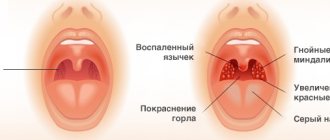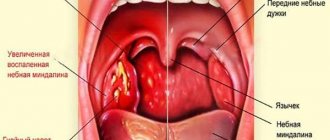Angina Simanovsky-Plaut-Vincent
Ulcerative - necrotizing tonsillitis in the modern world does not manifest itself in epidemics and occurs in a single variant, very rarely.
The disease develops due to an increase in opportunistic microorganisms that are part of the natural microflora of the patient’s body - the spindle-shaped rod spirochete Plaut-Vincent. Usually the bacterium does not pose a danger to the patient’s internal organs, but when exposed to negative factors, it leads to increased reproduction and stimulation of the manifestation of symptoms of the disease.
Necrotizing tonsillitis of the Simanovsky Vincent type, unlike ordinary purulent tonsillitis, is not characterized by acute symptoms.
Processes of the necrotic type - the death of soft tissues occur only on one side of the oral cavity, affecting one of the two tonsils. With the development of ulcerative necrotic tonsillitis, the disease tends to form numerous small ulcers over the entire surface of the tonsil. Without the proper treatment process, the disease deepens into the upper layers of the epithelium, reaching the bone tissue.
Necrotizing tonsillitis of a viral nature reveals its symptoms without purulent discharge, but requires urgent treatment. And fungal infection of the disease along with ulcerative formations is complicated by mixed bacterial infection. To determine the diagnosis and treatment with medications, you should consult a therapist or, in the case of a child, a pediatrician.
Forms of pathology
Plautan-Vincent's angina is divided into 3 forms. They are distributed according to the degree of severity and identification of the patient’s body temperature indicators:
- Mild stage - the patient’s temperature is either normal to 36.6 degrees, or slightly elevated to subfebrile - 37.0-37.1 degrees. In the oral cavity, redness of the palatine tonsils is visible, as well as plaque that does not spread over a large area of the mouth. There is slight painful discomfort during swallowing. There is no enlargement of lymph nodes.
- Moderate severity - body degrees increase to 37-38 degrees. A sore throat is detected during meals, an inflammatory process is observed in the tonsils, as well as their swelling. Dark spots form on the surface of the tonsils, in some situations acquiring a whitish tint. They have a round shape, growing up to 1.5 cm in diameter or connecting from several small neoplasms. If you try to remove the plaque with a cotton swab, you will find a bleeding surface under the white veil. Subsequently, the plaque will peel off, leaving large rags.
- Severe stage - the patient’s temperature rises to critical levels (39-40 degrees), changes in soft tissue pigmentation and swelling are present in the tonsils and spread over a large area, including the pharynx, palate, larynx and gums.
If the therapeutic effect is not carried out for a long time during the development of ulcerative sore throat, it leads to the development of such serious health problems and complications:
- Destruction of the soft tissues lining the surface of the larynx and gums;
- Tongue abscess;
- Perforations of the palate;
- Extensive necrosis of the upper layers of the epithelium;
- Sepsis;
- Bleeding;
- Loss of teeth and complete infection of the entire body.
Angina Simanovsky Plauta Vincent has 2 types, presented in the table.
| Types of sore throat | Description |
| Ulcerative | Inflammation is observed only on one side. Necrotic-type formations are covered with a yellow tint with the presence of a dirty sheen, layered, pasty consistency |
| Fibrinous-membranous | The disease is accompanied by a bacterial infection caused by an increase in the number of streptococci. The main symptom of the pathology is the formation of a dense yellow-gray film on the palatine tonsils. This severity of atypical angina is diagnosed in isolated cases |
Redness and the formation of purulent-necrotic ulcers are possible not only on the surface of the palatine tonsils, but can also be fixed on the muscle tissue, which is the retaining basis for the tooth roots. The pathology can also be localized on the inner surface of the mucous membrane of the cheeks. If left untreated for a long time, the patient's genitals are affected.
Features of the disease
Simanovsky-Plaut-Vincent tonsillitis refers to ulcerative-necrotic lesions of the mucous membrane of the mouth and larynx. The first outbreak of this disease was recorded back in 1888 in Finland, but a detailed description of its symptoms and characteristics of its course was made much later.
The causative agent of Simanovsky-Vincent angina is spindle-shaped bacilli, as well as spirochetes. These microorganisms are present in the oral cavity of every person and become pathogenic only under certain conditions, for example:
- weakening of the immune system;
- insufficient oral hygiene;
- alcoholism.
Most often, this disease occurs in exhausted and weakened people. Sometimes it can be epidemic in nature. Cases have been recorded where the development of a pathological process was caused by the presence in the oral cavity of carious teeth, gingivitis, periodontitis and many other diseases that promote the proliferation of pathogenic microorganisms.
Causes
The causative agents of the disease - spirochetes - are normal flora of the oral cavity, but when exposed to certain conditions, they actively multiply, causing inflammation. Necrotizing tonsillitis tends to manifest itself for some reasons:
- Infection of teeth with the formation of caries, inflammation of the gums, development of periodontitis;
- Detection of hypovitaminosis or vitamin deficiency;
- Physical exhaustion of the body;
- Nutritional dystrophy, which tends to manifest itself due to insufficient consumption of protein foods;
- Constant infection of internal organs in small dosages with harmful substances;
- Long-term therapy with antibacterial drugs;
- Parasitic type infections;
- Autoimmune diseases;
- Weakening of the immune system due to a prolonged course of a serious illness;
- Insufficient oral hygiene or its complete absence;
- Formations in the oral cavity of diseases that last a long time and are fixed in the chronic stage.
Vincent's sore throat can be triggered by a common cold. Therefore, most often the increase in the percentage of the disease occurs precisely when cold weather sets in. Infectious infection of the necrotic type affects a narrow group: men aged 18-40 years.
Symptoms of leakage
In most cases, angina of the Simanovsky Vincent type shows virtually no symptoms, developing unnoticed. The duration of the formation of signs is no more than 1 week. A visual examination by a doctor reveals a dirty yellow coating on the red background of the tonsils. The spray is easily removed from the tonsil, exposing ulcers on the soft tissues of the tonsil.
The following symptoms of an unpleasant disease are identified in different age categories, presented in the table.
| Signs of disease development | |
| In adult patients | In young patients |
| Painful discomfort in the larynx is practically not felt or is mild | Problems are detected in the functioning of the digestive organs |
| During swallowing there is a sensation of a foreign body in the larynx area | Baby loses appetite |
| The temperature remains at 37.5 degrees | Bacterial disease occurs in acute form |
| The tonsil area becomes noticeably swollen | Painful sensations in the throat, causing the baby to cry for a long time, causing a rise in temperature and problems sleeping |
| Lymph nodes under the jaw increase in size on the affected side | |
| The smell of rot comes from the mouth | |
| There is an increased production of sebaceous gland secretion | |
It is worth paying attention to the child’s condition and monitoring your own well-being. Sometimes parents confuse the symptoms of the disease with the development of diphtheria. If such signs are detected, you should immediately consult a doctor. If necessary, begin the treatment process immediately so as not to provoke the development of consequences.
Symptoms
Ulcerative tonsillitis at the beginning of its development does not have pronounced symptoms, but it intensifies as a secondary infection occurs, caused by staphylococci or streptococci.
Signs of the disease include:
- acute sore throat;
- putrid odor from the mouth;
- increased salivation;
- enlarged lymph nodes;
- chills;
- a sharp increase in temperature (above 37.5°);
- weakness;
- refusal to eat.
With proper treatment and diagnosis, the prognosis for recovery is positive, but if the patient delays visiting a doctor or refuses prescribed treatment, there is a high risk of complications.
Diagnostics
At the first examination by a specialist, the patient should tell when the first symptoms appeared. It is necessary to tell all the names of medications used previously, as well as tell about all previously suffered pathologies and existing diseases of a sluggish long-term type.
After this, the doctor examines the oral cavity and clarifies the emerging signs of Plaut’s angina, assesses the condition of the lymph nodes located under the jaw. Additionally, listens to the functioning of the heart and the presence of pulmonary rales.
Almost all tonsillitis in the first stages of its course does not reveal any peculiarities; the name is almost the same type of symptoms. Therefore, to directly detect the disease, you will need to undergo a laboratory examination:
- Blood test - detects an increase in leukocyte counts and an increase in ESR levels;
- A smear for bacterial culture allows you to accurately calculate the pathogen and determine the antibiotics to which the infection is more sensitive.
If the need arises, immune responses to pathogenic microorganisms are assessed, and an antibiogram is prepared.
Only based on accurately identified test results, the doctor can prescribe effective treatment that will quickly eliminate the clinical picture and avoid complications.
Carrying out diagnostics
Initially, the doctor conducts a visual examination and also clarifies the existing symptoms. It is imperative to tell everything in detail, since the correctness of the diagnosis largely depends on this.
After collecting an anamnesis, the specialist examines the throat using a pharyngoscope and palpates the cervical lymph nodes. In order to determine the number of leukocytes, monocytes and lymphocytes in the blood, as well as the erythrocyte sedimentation rate, a clinical blood test is prescribed.
To detect the causative agent of the disease and determine its sensitivity to antibacterial drugs, antibacterial culture from the nose and throat is prescribed. In order to study the body's immune reactions, a serological examination is carried out.
Treatment of the disease with medications
Treatment of sore throat of the Simanovsky Vincent variety occurs using physiotherapeutic methods and therapeutic agents. Antibacterial therapy is prescribed only based on the content of the diagnostic results. In this situation, the following groups of antibiotics perform well in the treatment process:
- Cephalosporins: Cefazolin, Cephalixin, Cephaloridine;
- Penicillins - Benzyl or Phenoxymethylpenicillin, as well as Amoxicillin;
- Azalides – Zitrolide, Hemomycin, Summed;
- Macrolides - Erythro-, Mideca-, Claritro- or Azithromycin.
If a severe inflammatory process occurs, then you need to listen to the therapist’s comments and inject antibiotics intravenously or intramuscularly. If complications such as purulent phlegmon or abscess develop, the patient is hospitalized in a hospital setting.
Along with antibiotic therapy, a local effect on the palatine tonsils is prescribed in the form of lubrication every 2 hours with Lugol's solution, Novarsenol or Neosalvaren and rinsing the mouth and larynx with antiseptics. The latter include such drugs as Miramistin, Chlorophyllipt, Furacilin solution.
If the patient has an increase in body temperature, it is recommended to use additional medications aimed at eliminating the fever and lowering high degrees to the patient’s normal state. It is also worth using analgesic medications to relieve pain while eating.
Be sure to saturate the body with vitamins, especially group B and ascorbic acid. These substances act on the body as detoxification. It is necessary to establish a drinking regime - introduce more liquids of any kind, except alcohol and soda.
Traditional treatment of Plaut Vincent's sore throat
In addition to medications, the doctor may prescribe an effect on the source of inflammation using medicinal herbs.
During the period of exacerbation, with severely manifested symptoms, the following treatment rules are recommended for a quick recovery:
- 60% sugar syrup is often applied as a treatment for ulcers. It can be replaced with powder.
- Combine sage, thyme, lavender, and dried juniper berries in equal proportions. The resulting material is 1 tbsp. pour 0.2 g. boiling water Leave in a water bath for ¼ hour, stirring frequently. Based on the prepared infusion, inhale for 5 minutes.
- Rinse solution based on salt and soda, 1 tsp each. by 0.2 g. warm boiled water.
- Sea water as a mouth rinse;
- Tincture of leafy plantain leaves.
It is impossible to cure the disease on your own using traditional medicine. But you can use medicinal infusions as rinses or inhalations.
Simanovsky-Vincent's tonsillitis: causes, symptoms and treatment features
Vincent-Simanovsky-Plaut angina is a necrotic lesion of the tonsils, provoked by a fusiform rod. Often, such a disease occurs in people who are exhausted and weakened by previous diseases. It especially often manifests itself when there is a lack of consumption of foods that are rich in proteins and amino acids.
Features of the disease
Simanovsky-Plaut-Vincent tonsillitis refers to ulcerative-necrotic lesions of the mucous membrane of the mouth and larynx. The first outbreak of this disease was recorded back in 1888 in Finland, but a detailed description of its symptoms and characteristics of its course was made much later.
The causative agent of Simanovsky-Vincent angina is spindle-shaped bacilli, as well as spirochetes. These microorganisms are present in the oral cavity of every person and become pathogenic only under certain conditions, for example:
- weakening of the immune system;
- insufficient oral hygiene;
- alcoholism.
Most often, this disease occurs in exhausted and weakened people. Sometimes it can be epidemic in nature. Cases have been recorded where the development of a pathological process was caused by the presence in the oral cavity of carious teeth, gingivitis, periodontitis and many other diseases that promote the proliferation of pathogenic microorganisms.
Why does the disease have such a name?
Diseases that bear the names of doctors appear only if a specialist has described in detail a rare form of the disease.
These include infectious, necrotic-ulcerative sore throat of Simanovsky-Plaut-Vincent. For the first time, its symptoms were described by a Russian otolaryngologist, Simanovsky.
The research was continued by the French doctors Vincent and Plaut, who managed to isolate the causative agent of this disease.
This rod is present in the mouth of every person, but inflammatory processes begin only when it actively multiplies.
Causes
The causes and symptoms of Simanovsky-Vincent angina can be different, so it is important to take into account provoking factors, as well as promptly recognize the onset of the pathological process, as it can provoke serious complications.
This is a fairly rare disease that occurs in approximately 3-5 people out of a thousand. Characterized by purulent-necrotic lesions of the tonsils.
Basically, the inflammatory process affects only one side, but there may be bilateral damage.
Necrotizing tonsillitis occurs mainly as a result of a previous infectious lesion of the oral mucosa, but it can also manifest itself as an independent disease. There are several factors that can provoke the formation of ulcerative-necrotic sore throat of Simanovsky-Vincent, for example, the following:
- deterioration of the immune system due to past illnesses;
- worms;
- systemic blood diseases;
- overwork;
- prolonged exposure to stress;
- violation of metabolic processes;
- lack of nutrients;
- infectious diseases.
In addition, the disease can occur in people suffering from malignant neoplasms, radiation sickness and leukemia. The formation of ulcers and necrotic lesions on the mucous membrane of the mouth and tonsils may also indicate insufficiently good oral hygiene.
Vincent-Simanovsky's angina can be primary or secondary. Gum suppuration and caries can trigger the onset of the primary form of the disease. Secondary infection is diagnosed in scarlet fever, diphtheria and other severe infectious diseases.
Main symptoms
Symptoms of Simanovsky-Plaut-Vincent angina directly depend on the degree of damage to the palatine tonsils. Among the characteristic signs of the disease are the following:
- enlargement of the palatine tonsils;
- temperature increase;
- bad breath;
- plaque on the tonsils;
- formation of ulcers;
- increased salivation.
In mild forms of the disease, the symptoms are similar to pharyngitis, which makes it even more insidious.
This form of the pathological process is characterized by a slight rise in temperature, no pain when swallowing, a feeling of soreness and dry mouth.
Areas of redness are very pronounced and localized on the surface of the tonsils; there is also a slight enlargement of the lymph nodes in the neck, but they are completely painless.
With necrotizing tonsillitis of moderate severity, the disease resembles tonsillitis. The characteristic features of this disease are:
- temperature increase;
- swollen lymph nodes;
- severe sore throat;
- upon visual examination, swelling and redness are noted;
- The mucous membrane of the tonsils becomes covered with whitish spots.
Symptoms of severe form are characterized by the fact that the disease very quickly develops into complications. Among the main signs of the disease are the following:
- patients develop a high temperature;
- inflammation quickly spreads to the oral cavity;
- the plaque is easily removed, ulcers form;
- swallowing causes severe pain;
- Not only the mucous membrane is affected, but also muscle, vascular and connective tissue.
Complications occur quite rarely, but it is important to properly diagnose and treat in order to quickly get rid of necrotic lesions.
Carrying out diagnostics
Initially, the doctor conducts a visual examination and also clarifies the existing symptoms. It is imperative to tell everything in detail, since the correctness of the diagnosis largely depends on this.
After collecting an anamnesis, the specialist examines the throat using a pharyngoscope and palpates the cervical lymph nodes. In order to determine the number of leukocytes, monocytes and lymphocytes in the blood, as well as the erythrocyte sedimentation rate, a clinical blood test is prescribed.
To detect the causative agent of the disease and determine its sensitivity to antibacterial drugs, antibacterial culture from the nose and throat is prescribed. In order to study the body's immune reactions, a serological examination is carried out.
Features of treatment
The peculiarity of the treatment of Simanovsky-Plaut-Vincent angina largely depends on the form of its course, as well as the presence of complications. In uncomplicated forms, the patient is hospitalized in the infectious diseases department for 1-3 weeks. Initially, it is necessary to ensure that the pathological process does not spread deep into the oral cavity and nearby tissues.
When carrying out therapy, medications, traditional medicine, vitamin therapy, inhalations are used, and you must also follow a special diet, which will allow you to achieve a faster recovery.
Use of drug therapy
Treatment of angina is quite lengthy and requires strict adherence to all doctor’s prescriptions. Antibacterial drugs and their dosage are selected strictly individually, only after bacteriological analysis. The following medications are considered the most effective:
- penicillins (“Amoxicillin”);
- cephalosporins (Cefazolin, Ceftriaxone);
- macrolides (Sumamed, Erythromycin).
With the correct use of antibacterial drugs, the signs of necrotizing tonsillitis disappear literally after 3-4 days. To achieve recovery, you need to complete a full course of antibacterial therapy, which is prescribed by the attending doctor. Often, patients are prescribed macrolides, since they are less aggressive and have minimal negative effects on the stomach and intestines.
In addition, macrolides differ from other antibacterial agents in their low level of toxicity, but have a good antimicrobial effect. It is advisable to administer drugs intramuscularly, but it is necessary to take into account the patient’s age, weight and severity of the disease.
In addition to the internal use of drugs, a local effect on the site of inflammation is required. To do this, the affected areas are treated daily with hydrogen peroxide, and you also need to gargle 4-5 times with a weak solution of potassium permanganate, and irrigate with sprays with an antibacterial effect. It is necessary to lubricate the tonsils with iodine solution and other iodine-containing preparations.
To get the maximum effect from therapy, a course of physiotherapeutic procedures is prescribed. The duration of such treatment is at least 10 days. If necessary, the course of physiotherapeutic procedures must be repeated.
Traditional medicine
Treatment of Vincent-Simanovsky's angina with folk remedies must necessarily be combined with antibacterial therapy. For gargling, it is recommended to use immunostimulating and anti-inflammatory drugs and decoctions, for example:
- decoction of raspberry leaves or branches;
- aloe;
- onion and garlic;
- salt solution;
- strong sugar solution;
- inhalations with herbal decoctions.
People prone to throat diseases definitely need to take care of their immunity, carefully maintain oral hygiene and treat dental diseases.
Diet
Vincent-Simanovsky's angina requires not only proper treatment, but also diet.
Since during the course of the disease the patient experiences severe pain in the throat and finds it difficult to swallow, all food consumed should be soft and warm.
Products should not contain aggressive components that will irritate the throat mucosa. In addition, the diet must be enriched with vitamins and proteins.
If the patient neglects the diet, this can significantly delay the healing process, which can lead to the development of various complications.
Carrying out prevention
In order not to carry out lengthy and expensive treatment, it is necessary to carry out certain preventive measures. Among the preventive measures are the following:
- proper and balanced nutrition is required;
- monitor your oral health;
- take vitamin supplements.
It is imperative to take care of strengthening the immune system, as well as timely treatment of diseases that can lead to its weakening.
Possible complications
The consequences of the disease can be very dangerous. If the disease continues for a long time, the superficial ulcers begin to become deeper and resemble craters in their shape that extend beyond the tonsils.
In some cases, this can lead to destruction of the bone wall, which provokes very serious bleeding. The disease can also affect gum tissue, as well as the tongue, which leads to their necrosis. This disease is very dangerous during pregnancy, which leads to oxygen starvation of the fetus, as well as miscarriage.
Source: https://fb.ru/article/368773/angina-simanovskogo-vensana-prichinyi-simptomyi-i-osobennosti-lecheniya
Prevention
To prevent the development of the disease, it is necessary to follow simple rules of preventive measures:
- During the cold season, warm yourself - wear clothes appropriate for the weather;
- Pay increased attention to chronic diseases, both throughout the body and in the oral cavity, and treat them in a timely manner;
- Carry out oral hygiene twice a day every day.
There are no other recommendations for preventing the disease. The main thing is to prevent the development of complications and their flow into the inflammatory process of Vincent Plaut's sore throat if a cold occurs.
Thus, Vincent’s angina is a serious disease that can develop complications and significantly worsen the patient’s health. Therefore, if prerequisites for the development of a peptic ulcer arise, it is worth starting the treatment process immediately.
Features of treatment
The peculiarity of the treatment of Simanovsky-Plaut-Vincent angina largely depends on the form of its course, as well as the presence of complications. In uncomplicated forms, the patient is hospitalized in the infectious diseases department for 1-3 weeks. Initially, it is necessary to ensure that the pathological process does not spread deep into the oral cavity and nearby tissues.
When carrying out therapy, medications, traditional medicine, vitamin therapy, inhalations are used, and you must also follow a special diet, which will allow you to achieve a faster recovery.










